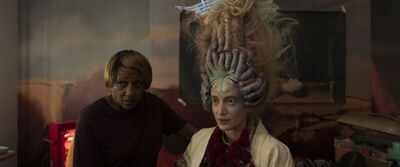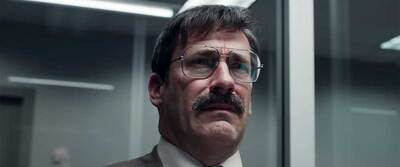Medusa Deluxe

Dazzlingly impressive from a technical perspective but frustratingly dull from a narrative one, “Medusa Deluxe” is an ambitious but uneven experience.
The feature filmmaking debut from British writer/director Thomas Hardiman is high on style but short on thrills, which is unfortunate given that it’s a murder mystery set in the wild world of competitive hairdressing. One of the stylists, Mosca, has been scalped during preparations for the big show; the others sit backstage in their respective dressing rooms, worrying and gossiping with their shocked models and speculating who among them might have been the killer.
It’s already a potentially juicy premise. But then Hardiman has chosen to tell this story in a single take, or rather to create the sensation that we’re watching a single take, which is actually a series of very long takes seamlessly stitched together. Working with expert cinematographer Robbie Ryan—whose eclectic filmography ranges from the crisp black-and-white of “C’mon C’mon” to his lavish, Oscar-nominated work on “The Favourite”—Hardiman glides effortlessly through hallways and up and down stairways. “Medusa Deluxe” feels like it has a lot of “Birdman” in its DNA with its lengthy Steadicam shots inside the mundane nooks of a theatrical setting and its sporadic treks to the sidewalks outside. The frequent mirror avoidance is especially clever, given how many scenes feature characters talking as they ponder their reflections in dressing rooms and bathrooms. And there’s one truly spectacular “how’d-they-do-that?” sequence at the film’s climax that made me rewind and rewatch a couple of times just to marvel at its choreography and pacing.
But beneath all the visual prowess, there is an actual story with actual characters, all of which is actually quite boring.
We begin with the volatile Cleve (a ferocious Clare Perkins), who delivers an extended rant as she arranges a frothy Georgian Fontange on the woman sitting before her. Soon, the camera follows a model named Inez (Kae Alexander) as she navigates the hallways with a towering pile of stick-straight, rainbow-hued tresses atop her head. Eventually, we spend time with the quiet security guard, Gac (Heider Ali), who asks to borrow some wipes to clean the blood off his locker. Flashy, freaked-out Rene (Darrell D’Silva), the show’s organizer, shares a vape with Gac as he debates what to do next. Rene must also contend with Angel (Luke Pasqualino), Mosca’s devastated partner and the co-father of their infant son, Pablo. (Introducing a baby in a Bjorn adds yet another degree of difficulty to the already complex mix, and boy, is he ever cute.)
And so on until we’ve met all the players, heard their stories, and considered their possible degrees of culpability. But regardless of their backgrounds and motivations, gripes and lies, a single factor unifies everyone: There’s nothing to them. Each character gets a trait or two, and quite often, they deliver their lines in such a uniformly understated way it’s hard to feel engaged in what they’re saying, much less wonder whether any of them could have been the killer. Given the gruesomeness of the attack and the flamboyant nature of the setting, “Medusa Deluxe” should be a lot more exciting. Despite the muscular camerawork and some inspired transitions, the overall pacing is slow. And the underlying crime going on within this crime scene isn’t especially intriguing, either.
Still, the percussive score from British electronic musician Koreless adds tension (there’s a cool back-and-forth effect involving a comb at a key moment). And, of course, the hair designs in “Medusa Deluxe” are structural marvels to behold. But it’s not enough to keep this whodunit from becoming a “Who cares?”
Now playing in select theaters and available on VOD.










